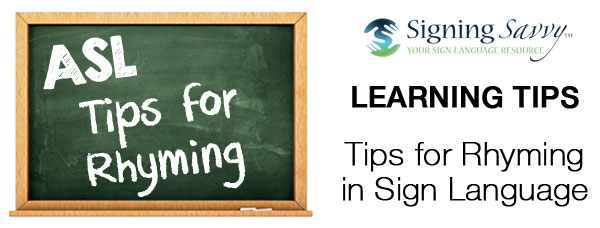
Tips for Rhyming in Sign Language
Every year around this time, I get a message or two from teachers and interpreters of deaf children asking how to best convey the concept of rhymes to their students. Rhyming is a very common curriculum goal in many, if not all early childhood education programs throughout the United States and Canada.
The problem often with rhyming is that many of the words are made-up and, therefore, they have no sign. We all know that words that have no sign should be fingerspelled if you follow proper ASL rules. You can fingerspell these nonsense words, but that isn’t always very interesting for the young deaf child to watch and doesn’t accurately convey the concept of rhyming words.
I stumbled upon this great video of Austin W. Andrews, an ASL storyteller also known as Awti, describing how to rhyme in sign language. He uses the classic nursery rhyme “Hey Diddle Diddle” as an example and does an excellent job of explaining how to handle rhyming when signing.
Some of Awti's great rhyming pointers include:
- Rhyming in English focuses on words that sound the same. ASL doesn’t use sound, so to use the principle of rhyming in ASL, signs should look the same.
- Rhyming is also based on repetition - repeating similar sounds in English to create an audible rhythm. Do the same thing in ASL by repeating similar signs to create a visual rhythm. Use movement, handshape, location, palm orientation, or other components of signs to create repetition and a visual rhythm.
- Stay true to the meaning of the rhyme, but don’t get caught up in delivering a direct translation of each word. To sign, “Hey Diddle Diddle,” Awti signs HI (for “Hey”) and then uses swinging arms for DIDDLE that mimic the movement of FIDDLE in the next line of the rhyme. Swimming arms may not be an ASL sign, but “Diddle” has little meaning in English as well and the point of rhyming is to establish a pattern, rhythm, and repetition (whether audible in English or visual in ASL).
Watch the short video to see Awti’s rhyming example in action. The video has no audio, but is captioned. If you are a fluent signer, you will not have a problem understanding the signing in the video, and that is actually the best way to watch it. If you aren’t a fluent signer yet (notice I said YET), then I suggest you watch the video a few times, first reading the captions so that you get the gist of the video and then go back and watch it again, focusing on the sign.
To turn the captions on, click the "CC" button at the bottom of the video.
Resources:
- McCulloch, Gretchen (2014, September 5). How Do You Rhyme in a Sign Language? Slate. Retreived 9/15/2014 from http://www.slate.com/blogs/lexicon_valley/2014/09/05/rhyming_in_a_sign_language_a_proposal_from_asl_storyteller_awti.html








Savvy User DanielleMonday, October 13, 2014
I found the rhyming to be very interesting. I also wonder if the word "jest" shouldn't have been "gist"